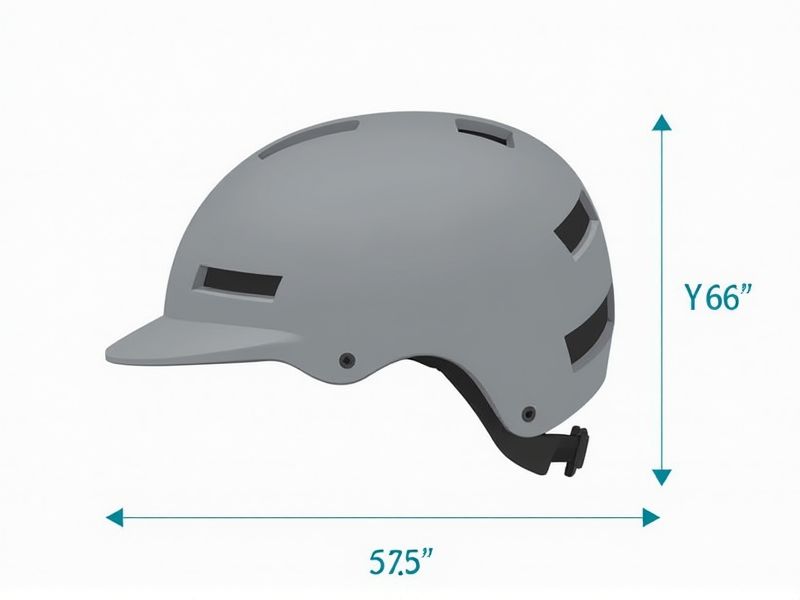
When shopping for a bicycle helmet, it's helpful to know that standard adult helmet sizes typically range from 51 to 63 centimeters in head circumference (measured around the largest part of your head, just above the eyebrows). Most adult helmets fall into sizing categories like small (51-55 cm), medium (55-59 cm), large (59-63 cm), and sometimes extra-large. Children's helmet sizes tend to range from about 47 to 57 centimeters, reflecting their smaller head sizes. To find the perfect fit, always measure your head with a flexible tape and refer to the manufacturer's sizing chart, as dimensions and fit styles may vary between brands.
Head Circumference Range
Bicycle helmets are designed to fit various head circumference ranges, typically from 52 to 62 centimeters, ensuring a secure yet comfortable fit for most users. The importance of selecting the right size helmet cannot be overstated, as a properly fitted helmet can reduce the risk of head injuries by up to 85%. Many helmets come with adjustable sizing systems to accommodate head shapes and ensure maximum protection during rides. When choosing a helmet, prioritize one that meets safety standards, such as CPSC or Snell, to guarantee adequate impact resistance and safety features.
Helmet Shell Size
The helmet shell size is crucial in ensuring optimal safety and comfort for cyclists. Standard sizes typically range from small (51-55 cm) to extra-large (61-65 cm), accommodating various head sizes. Proper fit minimizes the risk of movement during impacts, enhancing protection. Remember, investing in a helmet with the right shell size can significantly reduce the likelihood of head injuries in case of an accident.
Interior Padding Thickness
Bicycle helmets must adhere to specific standards regarding interior padding thickness, which typically ranges from 15 to 25 millimeters for optimal protection. This thickness enhances energy absorption during impacts, minimizing head injuries. Helmets that meet ANSI, CPSC, or ASTM certification standards guarantee that their interior padding can withstand significant forces, providing you with peace of mind while cycling. Investing in a helmet with adequate padding can decrease the risk of concussions and other serious head trauma by up to 85%.
Ventilation Opening Size
The ventilation opening size in bicycle helmets is crucial for ensuring effective airflow and temperature regulation. Typically, a well-designed helmet features multiple openings, enhancing comfort during long rides; an average scale for optimal vent size ranges from 10 to 15 square centimeters per vent. Research indicates that helmets with larger openings can reduce overheating by up to 40%, significantly improving performance. When selecting a helmet, prioritize those with a balanced number of vents while ensuring they meet safety standards for impact protection.
Strap Length
The standard for bicycle helmet strap length typically ranges from 10 to 12 inches, ensuring a secure yet comfortable fit for various head sizes. A properly adjusted strap enhances safety by preventing the helmet from shifting during use, a crucial factor, as improperly fitted helmets can decrease effectiveness in impact scenarios. Regular checks of your helmet's strap length are recommended, as wear and tear can lead to compromised security over time. Ensuring your helmet straps meet these standards can significantly improve your riding safety and comfort.
Adjustment Dial Range
The adjustment dial range of a bicycle helmet is crucial for achieving a secure and comfortable fit. Typically, high-quality helmets offer an adjustment dial range of 15 to 25 centimeters, accommodating various head sizes. Proper helmet fit enhances safety by ensuring that the helmet stays in place during rides, minimizing the risk of injury. To verify your helmet's adjustment dial efficiency, ensure that it allows for easy and effective tightening or loosening while maintaining a snug fit around your head.
Weight Specifications
Bicycle helmets typically weigh between 200 to 400 grams, influencing comfort and overall riding experience. Helmets that are lighter tend to enhance your performance, especially during long rides, as they reduce fatigue. The safety standards, such as CPSC in the United States and EN 1078 in Europe, emphasize that weight should not compromise protective features. Opting for a helmet within this weight range ensures optimal safety without sacrificing comfort during your cycling adventures.
Certification Standards
Bicycle helmets are primarily evaluated based on certification standards such as CPSC (Consumer Product Safety Commission) in the United States, EN 1078 in Europe, and AS/NZS 2063 in Australia. These standards ensure that helmets can withstand impact forces of at least 300 Gs to protect against head injuries. Look for a helmet that features multiple safety certifications for added assurance, as some models also comply with additional standards like ASTM F1447 for recreational cycling. Remember, a properly certified helmet can significantly reduce the risk of serious injury in the event of an accident.
Visor Attachment Size
The standard for bicycle helmets emphasizes that visor attachment size should not exceed 50 millimeters in height to ensure optimal safety and aerodynamic efficiency. This regulation helps maintain clear visibility while riding, as larger visors may obstruct peripheral vision or become a source of instability at high speeds. You should ensure that the visor is securely attached, as improper fittings can pose a risk during sudden movements or accidents. Adhering to these guidelines is crucial for reducing the likelihood of head injuries and enhancing overall riding comfort.
Aerodynamic Shape
A bicycle helmet designed with an aerodynamic shape can reduce drag by up to 20% during high-speed rides. This streamlined design not only enhances your overall speed but also improves stability while cycling. Several models, tested in wind tunnels, have shown a significant reduction in air resistance, contributing to better performance metrics for cyclists. Investing in a helmet with optimized aerodynamics can significantly impact your cycling experience, especially in competitive environments.
